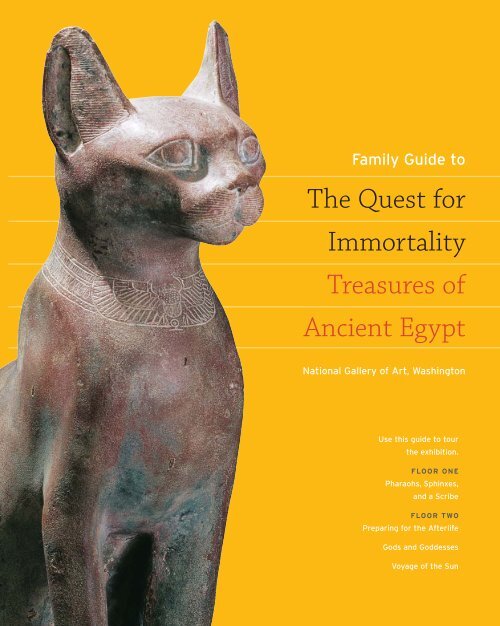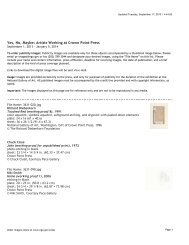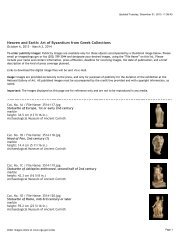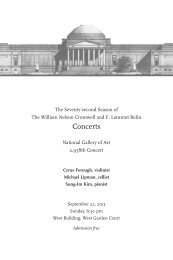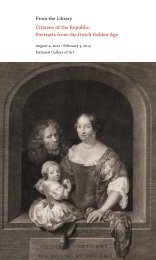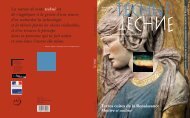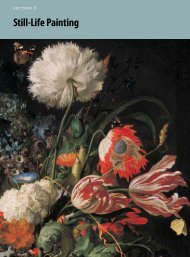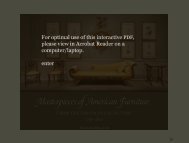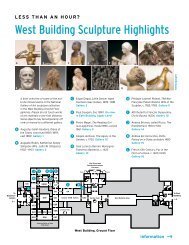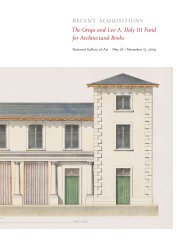The Quest for Immortality - National Gallery of Art
The Quest for Immortality - National Gallery of Art
The Quest for Immortality - National Gallery of Art
Create successful ePaper yourself
Turn your PDF publications into a flip-book with our unique Google optimized e-Paper software.
Family Guide to<br />
<strong>The</strong> <strong>Quest</strong> <strong>for</strong><br />
<strong>Immortality</strong><br />
Treasures <strong>of</strong><br />
Ancient Egypt<br />
<strong>National</strong> <strong>Gallery</strong> <strong>of</strong> <strong>Art</strong>, Washington<br />
Use this guide to tour<br />
the exhibition.<br />
FLOOR ONE<br />
Pharaohs, Sphinxes,<br />
and a Scribe<br />
FLOOR TWO<br />
Preparing <strong>for</strong> the Afterlife<br />
Gods and Goddesses<br />
Voyage <strong>of</strong> the Sun
Look <strong>for</strong> these<br />
symbols on objects<br />
throughout the<br />
exhibition.<br />
Re<br />
<strong>The</strong> solar disk, a sign<br />
<strong>of</strong> the sun god Re.<br />
You’ll find it everywhere!<br />
Ankh<br />
<strong>The</strong> hieroglyph <strong>for</strong><br />
“life.” It was one<br />
<strong>of</strong> Egypt’s most<br />
powerful symbols.<br />
<strong>The</strong> dead were called<br />
“ankhu” because they<br />
had eternal life.<br />
Living <strong>for</strong>ever—that’s immortality. Ancient Egyptians believed that after<br />
death, they could be reborn in the next world if they had led a good life.<br />
<strong>The</strong>y hoped that magic spells, the assistance <strong>of</strong> many gods, and the<br />
protection <strong>of</strong> mummification would help them reach the afterlife.<br />
Don’t be fooled, though. <strong>The</strong> Egyptians gave all this attention to death<br />
because they loved life on earth! <strong>The</strong>y hoped to go on living <strong>for</strong> eternity.<br />
Want to follow their quest <strong>for</strong> immortality?<br />
Track the objects on this tour. <strong>The</strong>y come from tombs and temples built by<br />
royal and wealthy families from 3,500 to 2,000 years ago. <strong>The</strong>y are very,<br />
very old but made in the hope that they would last <strong>for</strong>ever!<br />
<strong>The</strong> exhibition is organized by United Exhibits<br />
Group, Copenhagen, and the <strong>National</strong> <strong>Gallery</strong><br />
<strong>of</strong> <strong>Art</strong>, Washington, in association with the<br />
Supreme Council <strong>of</strong> Antiquities, Cairo.<br />
<strong>The</strong> exhibition is supported in part by<br />
Chevy Chase Bank.<br />
All works illustrated in the brochure are<br />
from the Egyptian Museum, Cairo.<br />
cover: Bronze cat, about 664 – 30 BC<br />
Prepared by the education division,<br />
<strong>National</strong> <strong>Gallery</strong> <strong>of</strong> <strong>Art</strong>, and produced<br />
by the publishing <strong>of</strong>fice.<br />
© 2002 Board <strong>of</strong> Trustees, <strong>National</strong> <strong>Gallery</strong><br />
<strong>of</strong> <strong>Art</strong>, Washington
2<br />
1<br />
FLOOR ONE<br />
Pharaohs, Sphinxes, and a Scribe<br />
Boat <strong>for</strong> the King<br />
<strong>The</strong> journey to immortality was made by boat.<br />
Why? That’s the way Egyptians got around<br />
in real life—by sailing on the Nile. Look <strong>for</strong><br />
the goddess Maat, pictured with her wings<br />
outspread, at one end <strong>of</strong> this boat. She kept<br />
the cycles <strong>of</strong> birth, death, and rebirth going.<br />
This boat was placed in the tomb <strong>of</strong> Pharaoh<br />
(king) Amenhotep II, an expert horseback<br />
rider and archer. He died in 1400 BC, and his<br />
mummy was found, still wrapped, in 1898,<br />
over three thousand years later.<br />
Sphinx <strong>of</strong> Thutmose III<br />
In the New Kingdom, the Egyptians believed<br />
the sphinx—part lion, part man—was a<br />
sun god. This one is carved with the face <strong>of</strong><br />
Pharaoh Thutmose III. Magically, the sphinx<br />
transfers the lion’s power to the king, along<br />
with the eternal life <strong>of</strong> the sun.<br />
Do you see the pharaoh’s beard? It’s false—<br />
look closely to see the straps that held it in<br />
place. Kings <strong>of</strong> ancient Egypt wore false<br />
beards as part <strong>of</strong> their <strong>of</strong>ficial costume.<br />
Scribe<br />
Have you noticed that many objects here<br />
are covered with writing? <strong>The</strong> written word<br />
was considered very powerful. Name something,<br />
and you can harness its magic.<br />
Egypt’s pr<strong>of</strong>essional writers were called<br />
scribes. This scribe works on a scroll spread<br />
across his lap. Do you see what’s hung over<br />
his left shoulder? It’s a palette holding two<br />
round cakes <strong>of</strong> ink, which were usually<br />
black and red. <strong>The</strong> scribe’s statue was in the<br />
temple <strong>of</strong> the god Amun. Some <strong>of</strong> his words<br />
promise to relay the prayers <strong>of</strong> visitors to<br />
the god. Apparently, many visitors accepted<br />
the <strong>of</strong>fer and rubbed parts <strong>of</strong> the inscription<br />
smooth.<br />
1 Boat from the tomb <strong>of</strong> Amenhotep II,<br />
1427 – 1400 BC, painted wood<br />
2 Sphinx <strong>of</strong> Thutmose III, 1479 – 1425 BC,<br />
granodiorite (stone)<br />
3 Amenhotep, son <strong>of</strong> Hapu, as a scribe,<br />
1390 – 1352 BC, granodiorite (stone)<br />
3<br />
Kheper<br />
Kheper means scarab<br />
beetle. <strong>The</strong> kheper<br />
sometimes lays its<br />
eggs inside a dung<br />
ball. Later, newborn<br />
beetles hatch from<br />
it as if magically<br />
created out <strong>of</strong> nothing.<br />
Ancient Egyptians<br />
believed that, like the<br />
beetle, the sun was<br />
reborn from death.<br />
Thus, the scarab<br />
beetle god Khepri<br />
became a symbol <strong>of</strong><br />
the rising sun and<br />
rebirth.
Djed pillar<br />
<strong>The</strong> pillar signifies<br />
“stability.” It is a<br />
sign <strong>of</strong> Osiris, god<br />
<strong>of</strong> the underworld.<br />
Egyptians thought it<br />
looked like his backbone.<br />
Colors were symbols,<br />
too. Black stood <strong>for</strong><br />
rebirth because black<br />
mud from the Nile<br />
made the soil good<br />
<strong>for</strong> planting. Red and<br />
yellow were colors<br />
<strong>of</strong> the sun. Green<br />
and blue were the<br />
colors <strong>of</strong> growth and<br />
there<strong>for</strong>e rebirth.<br />
Blue also reminded<br />
Egyptians <strong>of</strong> the<br />
Nile River and the<br />
heavens.<br />
4<br />
FLOOR TWO<br />
Preparing <strong>for</strong> the Afterlife<br />
Passage to the afterlife was not automatic.<br />
Your body had to be prepared <strong>for</strong> immortality.<br />
Mummification was the first step.<br />
Canopic Jars<br />
Step one: Your important internal organs were<br />
removed, dried in salts, individually wrapped<br />
in linen, and placed in canopic jars. See the<br />
lids? <strong>The</strong>y represent the gods who protected<br />
the contents <strong>of</strong> these jars.<br />
• Into the jar with the hawk head went the<br />
intestines.<br />
• Into the jar with the jackal head went the<br />
stomach.<br />
• Into the jar with the baboon head went the<br />
lungs.<br />
• And into the jar with the human head went<br />
the liver.<br />
Jewelry<br />
Step two: Your body was dried with salts,<br />
perfumed with oils and herbs, wrapped in<br />
strips <strong>of</strong> linen, and decorated with<br />
jewelry and magic amulets—<br />
protective charms. In this<br />
room you can see charms<br />
5<br />
and jewelry once worn by royal mummies,<br />
such as this vulture bracelet. It belonged to<br />
Queen Ahhotep. <strong>The</strong> vulture was especially<br />
associated with queens.<br />
C<strong>of</strong>fin <strong>of</strong><br />
Isis-em-akhbit<br />
Step three: Now you’re a<br />
mummy! Once mummified,<br />
every dead person<br />
was called “Osiris,” the<br />
name <strong>of</strong> the king <strong>of</strong> the<br />
underworld. If you had<br />
enough money, you<br />
might be put in a c<strong>of</strong>fin<br />
like this one, to give your<br />
body further protection<br />
on its journey to eternal<br />
life. This c<strong>of</strong>fin top looks<br />
like the wrapped mummy<br />
inside. She was Princess<br />
Isis-em-akhbit. You can see<br />
that she wore black eye<br />
makeup, gold earrings and<br />
hair adornments, and rows<br />
<strong>of</strong> jewelry around her neck.<br />
Sarcophagus <strong>of</strong> Khonsu<br />
Step four: A sarcophagus was an outer c<strong>of</strong>fin<br />
that provided yet another layer <strong>of</strong> protection<br />
<strong>for</strong> the deceased. It was usually made <strong>of</strong> wood<br />
or stone. This sarcophagus is painted with<br />
scenes <strong>of</strong> the journey to the afterlife described<br />
in the Book <strong>of</strong> the Dead.<br />
6
7<br />
Look <strong>for</strong> the mummy laid out on a lionshaped<br />
bed. Leaning over, tending to the<br />
mummy, is the jackal-headed Anubis, the<br />
god whose job was to embalm and wrap the<br />
dead and protect them. At far left you can<br />
see the bird-bodied souls—called bas—<strong>of</strong><br />
the deceased and his wife. <strong>The</strong> two bas sit<br />
be<strong>for</strong>e an <strong>of</strong>fering table piled high with<br />
round breads and flowers. It was important<br />
to make <strong>of</strong>ferings the dead could enjoy in<br />
the afterlife!<br />
Ushebti<br />
Small mummy-shaped figures called<br />
ushebtis or shabtis, are on view here and in<br />
the room be<strong>for</strong>e this. Egyptians believed<br />
that life in the afterworld would be like that<br />
on earth, but better. <strong>The</strong>se tiny models were<br />
8<br />
made to do your work in the afterworld<br />
magically. For most people, life in Egypt<br />
centered on planting crops and working<br />
estates along the great Nile River. This ushebti<br />
holds a hoe in each hand and has a bag on<br />
each shoulder containing seeds to plant, all<br />
painted onto the statuette. Go back one room<br />
to see another ushebti with actual hoes,<br />
bags, and other tools made in miniature.<br />
4 Canopic jars <strong>of</strong> Prince Hornakht,<br />
874 – 850 BC, alabaster<br />
5 Vulture bracelet <strong>of</strong> Queen Ahhotep,<br />
1550 – 1525 BC, gold, inlaid with<br />
lapis lazuli, carnelian, and turquoise<br />
6 C<strong>of</strong>fin <strong>of</strong> Isis-em-akhbit, 959 –<br />
945 BC, painted wood and gold<br />
7 Detail, Sarcophagus <strong>of</strong> Khonsu,<br />
about 1270 BC, stuccoed, painted,<br />
and varnished wood<br />
8 Ushebti <strong>of</strong> Khabekhnet, about<br />
1270 BC, painted limestone<br />
Horus<br />
<strong>The</strong> falcon represents<br />
Horus, the god <strong>of</strong><br />
the sky. Egyptians<br />
believed their<br />
pharaohs were the<br />
god Horus living on<br />
earth. So, when you<br />
see a falcon, it can<br />
suggest the presence<br />
<strong>of</strong> the pharaoh, too.<br />
Wedjat eye<br />
This is the eye <strong>of</strong><br />
Horus. It combines a<br />
human eye with the<br />
markings <strong>of</strong> a falcon<br />
and means “the<br />
sound one.” <strong>The</strong><br />
Egyptians believed<br />
that Horus’ eye had<br />
been restored after<br />
it was ripped apart<br />
by the god <strong>of</strong> chaos.<br />
So this sign was a<br />
powerful charm <strong>for</strong><br />
health and <strong>for</strong><br />
keeping the body<br />
whole — the aim <strong>of</strong><br />
mummification.
Tyet (Isis knot)<br />
Isis was the wife <strong>of</strong><br />
Osiris, god <strong>of</strong> the<br />
underworld. She<br />
helped the dead<br />
reach the afterlife.<br />
This symbol, called<br />
the Isis knot, provided<br />
the magical<br />
protection <strong>for</strong> which<br />
this goddess was<br />
known.<br />
Name <strong>of</strong><br />
Thutmose III<br />
Names <strong>of</strong> pharaohs<br />
were written in<br />
hieroglyphs inside<br />
an oval frame, called<br />
a cartouche. This<br />
is the throne name<br />
<strong>of</strong> Thutmose III,<br />
Menkheperre.<br />
Recognize the sun<br />
(Re) and scarab<br />
(kheper)?<br />
Gods and Goddesses<br />
9<br />
Bastet<br />
<strong>The</strong> word <strong>for</strong> “cat” in Egyptian was miu, pronounced<br />
“mew,” the sound a cat makes. <strong>The</strong><br />
sun god Re had seventy-five <strong>for</strong>ms, and<br />
several <strong>of</strong> them were cats, including “Miuty<br />
aa,” the “great female cat.” <strong>The</strong> cat goddess<br />
Bastet was also considered a daughter <strong>of</strong><br />
the sun god.<br />
Egyptians kept cats as household pets, along<br />
with dogs, monkeys, even gazelles. Cats were<br />
also raised in temples and were made into<br />
little cat mummies.<br />
Isis<br />
Isis was the wife <strong>of</strong> Osiris, lord <strong>of</strong> the underworld.<br />
Through magic, she helped Osiris<br />
defeat death, so the Egyptians believed she<br />
could also ease the passage <strong>of</strong> ordinary people<br />
to the afterlife. Isis, like all important goddesses,<br />
was a mother—in her case <strong>of</strong> Horus,<br />
the falcon. Her horned headdress was worn by<br />
all major<br />
goddesses because it<br />
was associated with the sun<br />
and the heavens.<br />
Sakhmet<br />
<strong>The</strong> lionness Sakhmet, strong<br />
and sometimes vengeful, was a<br />
fierce protector <strong>of</strong> the sun god.<br />
Her names mean “she who is<br />
powerful”—powerful in<br />
magic especially. She could<br />
determine people’s good or<br />
bad luck, protect their<br />
health, and ensure the<br />
annual flooding <strong>of</strong> the Nile<br />
on which Egypt depended.<br />
<strong>The</strong> inscription on this<br />
statue describes Sakhmet<br />
as “mistress <strong>of</strong> fear.”<br />
Traces <strong>of</strong> paint suggest<br />
that her eyes may have<br />
been colored red.<br />
11<br />
10
Osiris<br />
Osiris was the absolute ruler <strong>of</strong> the underworld<br />
but he began as a beloved lord <strong>of</strong> the<br />
earth. After he was killed and torn apart by<br />
his jealous brother, his wife Isis collected the<br />
parts <strong>of</strong> his body, and Anubis wrapped them<br />
together, returning him to existence. In this<br />
statue, Osiris is just beginning to rise up and<br />
live again.<br />
One <strong>of</strong> Osiris’ roles was to judge the souls <strong>of</strong><br />
the dead. <strong>The</strong> deceased’s heart was weighed<br />
against a feather, known as the feather <strong>of</strong><br />
truth, to determine whether he or she merited<br />
admittance to the afterlife.<br />
Thoth<br />
Thoth, a moon god, was responsible <strong>for</strong><br />
writing and knowledge. He is sometimes<br />
shown as an ibis, as here, sometimes as a<br />
baboon. Since Thoth was the scribe <strong>of</strong> the<br />
gods, he was the one who recorded the<br />
verdict <strong>of</strong> Osiris when the hearts <strong>of</strong><br />
the dead were weighed. With him on<br />
this statue is Maat, whose feather<br />
provided the balance.<br />
13<br />
12<br />
9 Bronze cat, about 664 – 30 BC<br />
10 Statue <strong>of</strong> Isis, 664 – 525 BC,<br />
graywacke (stone)<br />
11 Seated statue <strong>of</strong> the goddess<br />
Sakhmet, “mistress <strong>of</strong> fear,”<br />
1390 – 1352 BC, granodiorite (stone)<br />
12 Osiris resurrecting, 664 – 525 BC,<br />
gneiss (stone), with headdress in<br />
electrum (alloy <strong>of</strong> gold and silver)<br />
and gold<br />
13 Thoth and Maat, 664 – 332 BC,<br />
wood and bronze<br />
Red crown<br />
At one point in<br />
ancient times Egypt<br />
was two kingdoms,<br />
one in the north and<br />
another in the south.<br />
<strong>The</strong> red crown was<br />
worn by the ruler <strong>of</strong><br />
the north.<br />
White crown<br />
<strong>The</strong> white crown was<br />
worn by the ruler <strong>of</strong><br />
the south.
Flail and crook<br />
<strong>The</strong> pharaoh carries<br />
these symbols <strong>of</strong><br />
his power as king —<br />
shepherd and master<br />
<strong>of</strong> his people.<br />
Palm branch<br />
Each year the<br />
Egyptians notched a<br />
palm branch, so this<br />
symbol represents<br />
the passage <strong>of</strong> time.<br />
14<br />
Hathor<br />
Hathor, like Isis, was <strong>of</strong>ten seen as the mother<br />
<strong>of</strong> the pharaoh. She was also a goddess <strong>of</strong><br />
love, music, and dancing.<br />
Though she <strong>of</strong>ten wears a crown with cow<br />
horns, this pendant shows her with cow ears<br />
instead. <strong>The</strong> blue stone is lapis lazuli from<br />
Afghanistan, which was highly prized. <strong>The</strong><br />
Egyptians thought its blue color imitated<br />
the heavens. Details are inlaid in gold, which<br />
the Egyptians called “the flesh <strong>of</strong> the gods”<br />
because it retained its brilliance <strong>for</strong> all<br />
eternity.<br />
Maat<br />
Maat, who wears a feather crown, personified<br />
the natural order <strong>of</strong> the universe. She also<br />
represented the proper conduct required<br />
during life. It was against her feather—the<br />
“feather <strong>of</strong> truth”—that the hearts <strong>of</strong> the<br />
dead were judged.<br />
15<br />
14 Pendant in the <strong>for</strong>m <strong>of</strong> a Hathoric<br />
head, 874 – 850 BC, gold and lapis<br />
lazuli<br />
15 Goddess Maat, about 800 – 700 BC,<br />
lapis lazuli and gold
16<br />
Voyage <strong>of</strong> the Sun<br />
Let’s say you’re a pharaoh. You’ve been mummified.<br />
Placed in c<strong>of</strong>fins and a sarcophagus.<br />
Your organs are in canopic jars. You’ve got<br />
magic ushebtis. But you can’t reach the<br />
afterlife until you take that dangerous trip<br />
through the netherworld. As pharaoh you<br />
have a special book called the Amduat that<br />
describes the journey. Pharaoh Thutmose III<br />
had the whole book painted on the walls <strong>of</strong><br />
his burial chamber. It is re-created in this<br />
last gallery.<br />
An oval room? It mirrored the shape <strong>of</strong> the<br />
sun’s daily voyage and the shape <strong>of</strong> the universe.<br />
Pharaohs enclosed their names in an<br />
oval, or cartouche, because this indicated their<br />
rule over the whole area <strong>of</strong> the sun’s daily<br />
circuit. <strong>The</strong> oval sarcophagus room did the<br />
same thing.<br />
<strong>The</strong> Egyptians believed<br />
that the sun did not<br />
simply set each evening<br />
but actually died and was<br />
reborn at dawn. <strong>The</strong><br />
dead pharaoh follows<br />
the voyage <strong>of</strong> the sun<br />
through the twelve hours<br />
<strong>of</strong> night to reach the<br />
afterlife. His boat moves<br />
along the river in the<br />
center. <strong>The</strong>re are deserts<br />
and snakes. Demons try<br />
to halt the boat. No fewer<br />
than 471 deities <strong>of</strong>fer<br />
help along the way. In the<br />
twelfth and final hour, the pharaoh is reborn<br />
into the afterlife, and the sun appears at dawn<br />
as the solar beetle.<br />
17<br />
16 Detail, Twelfth Hour <strong>of</strong> the Amduat,<br />
about 1425 BC<br />
17 View <strong>of</strong> the tomb <strong>of</strong> Thutmose III,<br />
Valley <strong>of</strong> the Kings, <strong>The</strong>bes<br />
(present-day Luxor), Egypt<br />
Hetep (<strong>of</strong>fering<br />
table sign)<br />
This sign has the<br />
shape <strong>of</strong> a loaf <strong>of</strong><br />
bread on an <strong>of</strong>fering<br />
table. It means to<br />
“<strong>of</strong>fer” or “be content.”
HOME ACTIVITIES<br />
<strong>The</strong> Afterpage<br />
<strong>The</strong> Name Game<br />
Egyptians believed that writing someone’s<br />
name inside the shape <strong>of</strong> a cartouche (oval<br />
frame) indicated a king. Using the hieroglyphics<br />
chart on the back cover, create your<br />
own cartouche. You can also use hieroglyphics<br />
to write secret messages to your family and<br />
friends. Save the chart to help decode the<br />
message.<br />
Sorting Symbols<br />
Match the symbols on the left with the words<br />
on the right.<br />
ankh<br />
kheper<br />
djed pillar<br />
Horus<br />
wedjat eye<br />
tyet (Isis knot)<br />
red crown<br />
white crown<br />
flail and crook<br />
palm branch<br />
hetep (<strong>of</strong>fering<br />
table sign)<br />
Re
Sar-box-agus<br />
Create a mini-sarcophagus from a shoe box.<br />
Cover the box and lid using construction<br />
paper or a brown paper bag. Next, using the<br />
symbols from this family guide and others<br />
you may have seen in the exhibition, create a<br />
colorful pattern <strong>of</strong> protective symbols and<br />
good <strong>for</strong>tune on the lid and sides <strong>of</strong> the sarcophagus.<br />
Now, you can use the box to store<br />
the things that you would like to keep <strong>for</strong>ever!<br />
Did You Know...<br />
True or false? Test your knowledge about<br />
Egypt.<br />
1. Egypt is located in Africa.<br />
T___ F___<br />
2. It also borders on the Middle East.<br />
T___ F___<br />
3. Egypt’s main river is the Amazon.<br />
T___ F___<br />
4. Camels have always lived in Egypt.<br />
T___ F___<br />
5. An ancient Egyptian week had ten days.<br />
T___ F___<br />
6. Mummification included removal <strong>of</strong> the<br />
brain.<br />
T___ F___<br />
7. Mummy spelled backward is yummy.<br />
T___ F___<br />
(Answers are on next page.)<br />
Sphinx Yourself<br />
In the Sphinx <strong>of</strong> Thutmose III, we saw that<br />
joining the lion’s body with Thutmose’s face<br />
magically gave the pharaoh power. Create a<br />
portrait <strong>of</strong> yourself as part human, part beast.<br />
Which animal parts would you select—the<br />
quick legs <strong>of</strong> a cheetah, the powerful wings <strong>of</strong><br />
an eagle, the sleek fins <strong>of</strong> a dolphin? You<br />
decide.<br />
Draw here:
Hieroglyphics Chart Netherwebs<br />
A<br />
D<br />
G<br />
J<br />
M<br />
P<br />
S<br />
V<br />
Y<br />
B<br />
E<br />
H<br />
K<br />
N<br />
Q<br />
T<br />
W<br />
Z<br />
C<br />
F<br />
I<br />
L<br />
O<br />
R<br />
U<br />
X<br />
Check out these web sites <strong>for</strong> more.<br />
Mummify an apple and other activities.<br />
http://www.ktca.org/newtons/13/<br />
mummy.html<br />
For an interactive, mummy-making<br />
experience, consult “I Read It in the Book<br />
<strong>of</strong> the Dead.” Once at this url, click Begin<br />
Tour and then 18 , “Mummification.”<br />
www.chicagowebdocent.org/Public/index.html<br />
Try these Egyptian math problems.<br />
http://cuip.uchicago.edu/wit/99/teams/<br />
egyptmath/mathproblems.htm<br />
Learn how to play senet, an ancient Egyptian<br />
board game.<br />
http://www.ancientegypt.co.uk/life/<br />
activity/main.html<br />
Find more in<strong>for</strong>mation, puzzles, and games.<br />
http://www.rom.on.ca/egypt/<br />
http://touregypt.net/kids/<br />
http://www.seaworld.org/Egypt/egypt.html<br />
Answer Key to Did You Know. . .<br />
1: T<br />
2: T<br />
3: F—It’s the Nile.<br />
4: F—<strong>The</strong>re were no camels in ancient Egypt.<br />
5: T<br />
6: T<br />
7: F—You must be hungry!


